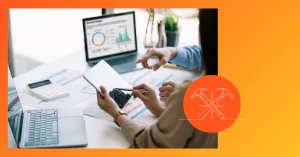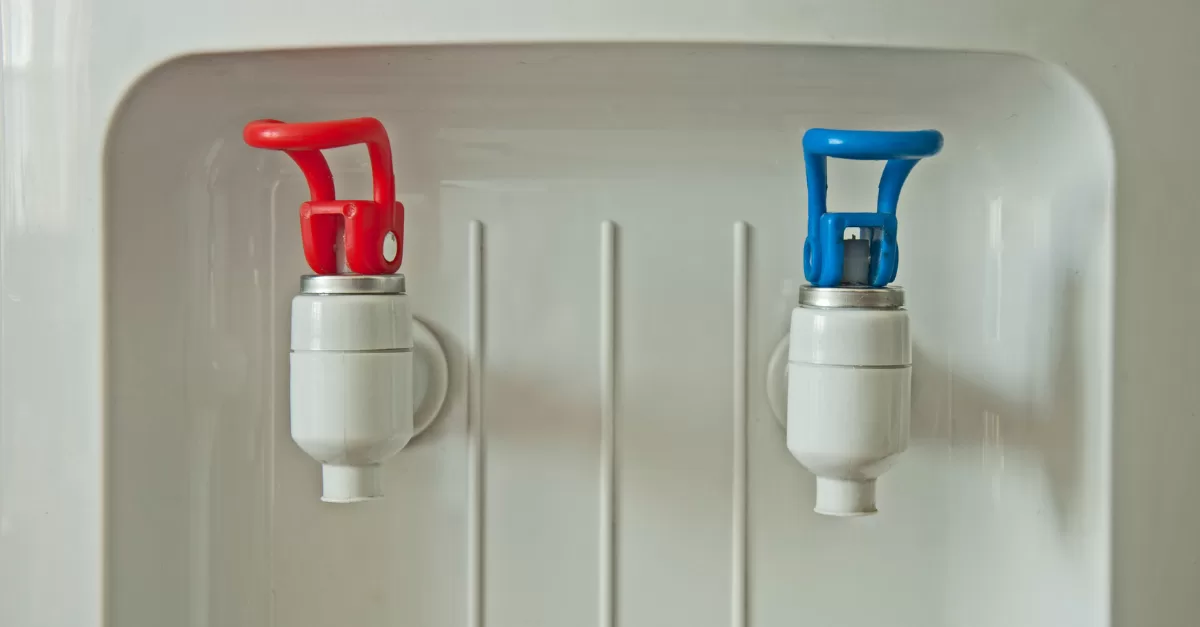Houston (and by Houston, I mean businesses), we have a problem: According to Salesforce, 68% of customers expect brands to understand their unique needs and expectations, but only 39% of customers feel that brands actually do this.
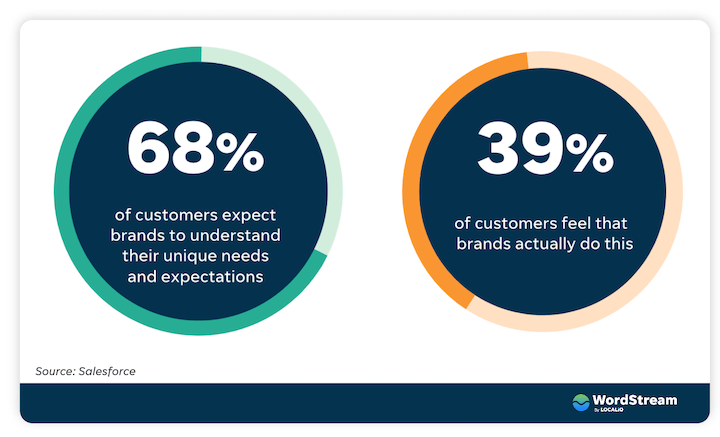
This is 🆖 (not good). So how do you make sure you’re actually being customer-centric?
Enter the customer journey map: A powerful tool to help you fully understand your customers so you can establish meaningful connections, improve the overall experience, and drive long-term business growth.
Read on to learn more about what a customer journey map is, why you need one, and how to create one (with our free template!)
Table of contents
- What is a customer journey map
- Why customer journey mapping?
- Customer journey map template
- How to create a customer journey map
- Free customer journey map templates
What is a customer journey map?
A customer journey map is a visual representation of your customers’ experience with your business as they progress through your funnel—but not the overall experience. Rather, it breaks down the entire journey into key stages and touch points and digs into the specific intentions, emotions, and behaviors at each one.
Because of their granular nature, businesses create customer journey maps for specific personas on specific paths to purchase. So if you have more than one offering and/or more than one buyer persona, you’ll want to create multiple customer journey maps. More on that later.
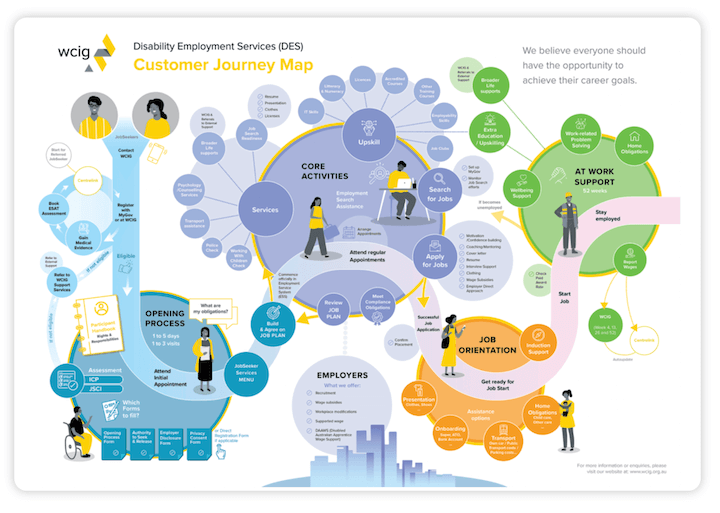
Why is a customer journey map important?
A customer journey map allows you to identify the micro-moments that make up the full experience of your brand. Micro moments that, when assessed and improved, mean the difference between good service and impressive service; between great products and unforgettable ones; between happy customers and ecstatic, review-writing, referring, loyal customers.
Put another way, customer journey mapping is how you understand and improve the experience at every level to deliver the personalized experience that consumers expect today, which:
- Guides your content marketing strategy
- Improves your products, services, and marketing content
- Enables cross-channel marketing and omnichannel marketing
- Improves retention along the funnel
- Separates you from competitors
(You can even use a customer journey map to further define that separation, as with the example below.)
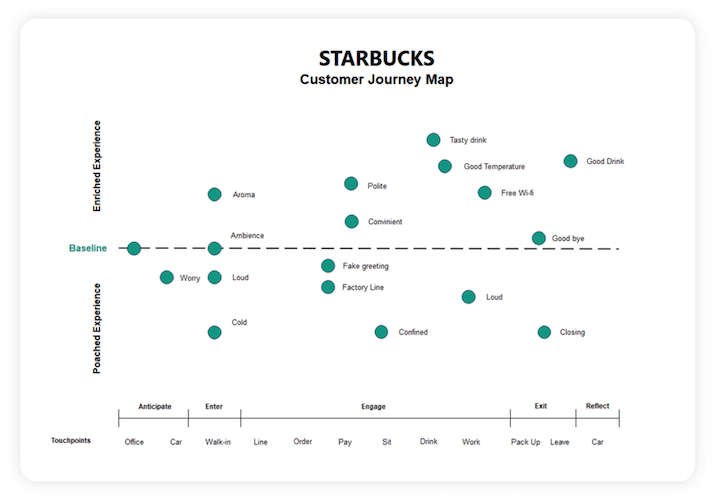
All of this ultimately results in:
- More sales
- Less churn
- A more holistic growth marketing strategy
Plus, the exercise itself requires the collection of customer insights through data, feedback, and more, which strengthens your client relationships.
The three elements of a customer journey map
A customer journey map is a marketing mashup. You’re basically taking the buyer’s journey, layering on the offers in your marketing funnel, and then stirring in your buyer personas, all to paint a detailed story of the physical and emotional experience of your brand as experienced by the customer.
Let’s unpack each of those elements, shall we?
1. Buyer persona
In order to capture the intentions, experiences, emotions, and actions of your customers at each point in their journey, you need to understand who they are to begin with: their lifestyle, what motivates them, what keeps them up at night, what makes them tick. This is what a buyer persona is—a fictional character with a life and a brain and a heart who represents your ideal customer.
This is the context you need in order to pinpoint the highly-specific information in a customer journey map. Which is why you need to create separate customer journey maps for each persona. Business Owner Betty is going to be driven by a completely different set of values, motivations, and desires than Marketing Manager Mara.
2. Marketing funnel
The second element of a customer journey map is your marketing funnel. This is a visual representation of how leads turn into customers and customers into loyal customers for your business. It’s broken down into the different stages of this process and what you offer at each stage.
There are a bajillion different ways of naming the stages of the marketing funnel, but in general, they are as follows:
- Awareness
- Interest/consideration
- Evaluation
- Desire
- Action/conversion
- Retention
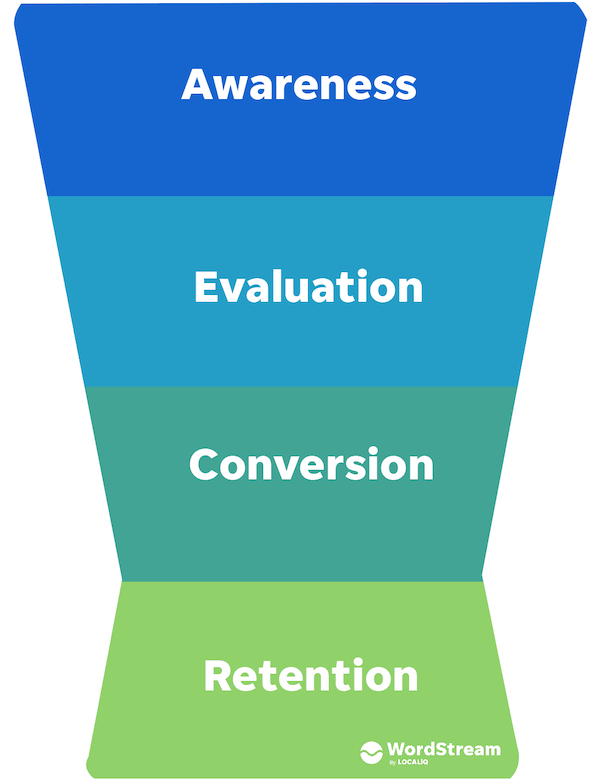
3. The buyer’s journey
The last element of a customer journey map is the buyers’ journey. While your marketing funnel is the top-to-bottom, business-focused path, your buyer journey is the left-to-right, customer-focused narrative. Here are the five stages of the buyer journey as it pertains to customer journey mapping:
- Awareness: The customer is aware of their problem and searching for ways to solve it or the symptoms associated with it.
- Consideration: The customer is now aware of the solution to the problem, and your particular solution, but they’re still researching it to see if it’s right for them.
- Decision: The customer is ready to buy and has decided that your product solves what they need.
- Service: The customer uses the product or service your business offers and receives support as needed.
- Retention: The customer is satisfied with your product or service and continues using you for this particular need.
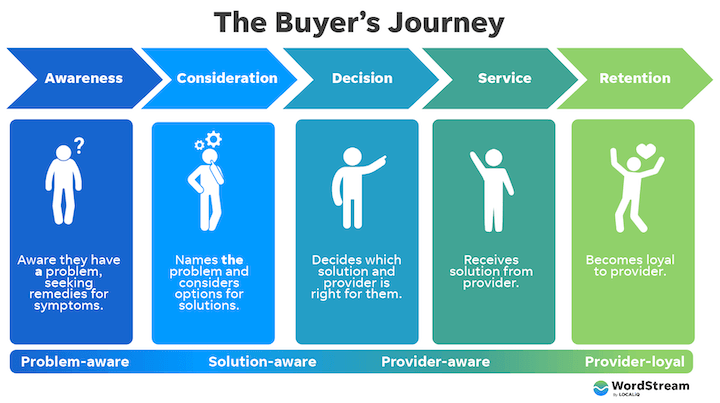
Place all three in a blender and what you get is a customer journey map.
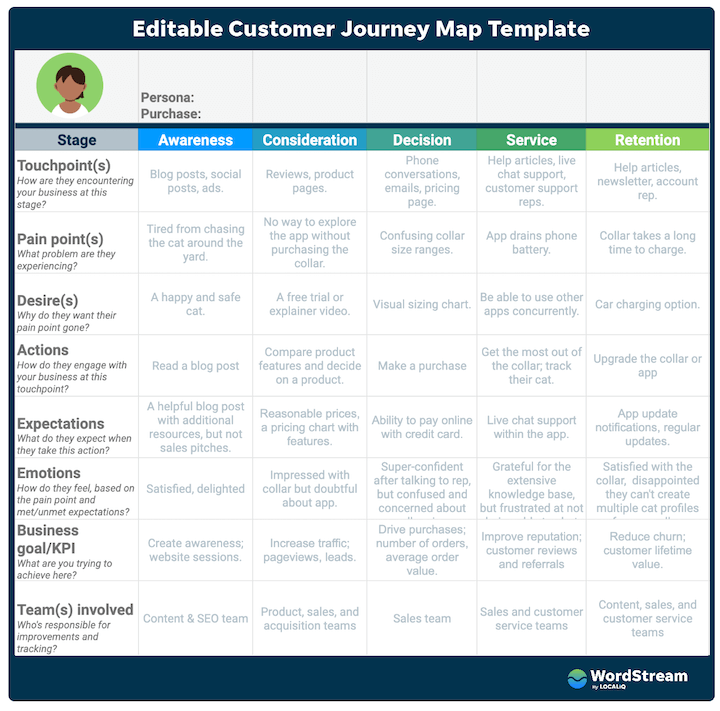
Get the blank customer journey map template here.
How to make your own customer journey map
So now, provided you know your customer personas and which journey you’re covering, you can create a customer journey map. You’ll do this by breaking down your buyer’s journey into the five stages listed above and collecting the below data points for each one.
1. Touchpoints
Touchpoints are the online and offline mediums through which a customer encounters and interacts with your business, like phone calls, pages on your website, social media posts, surveys, flyers, and the list goes on.
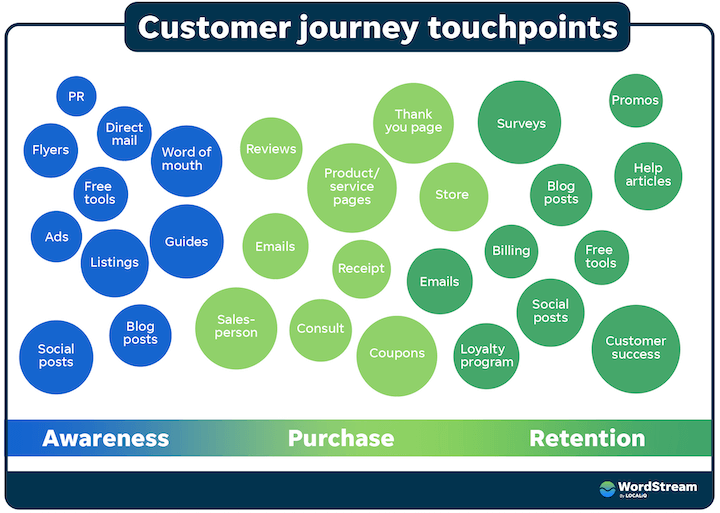
There are a number of ways a customer can interact with your business at any stage, but for the purpose of your map, just include 1-3 of the core ones. For example:
- Awareness: Blog posts, social posts, ads.
- Consideration: Reviews, product pages.
- Decision: Phone conversations, emails, pricing page.
- Service: Help articles, live chat support, customer support reps.
- Retention: Help articles, newsletter, account rep.
By listing these out first, you’ll have the context you need in order to establish subsequent data points like pain points, desires, actions, and expectations.
2. Pain points
Customer pain points are the specific problems your customers are experiencing—problems for which they’re seeking a solution. Of course, your final product or service solves for a certain set of pain points, but in the case of customer journey mapping, you’ll also want to address certain pain points that arise in their interactions with your business.
Let’s say you’re a company that has a tracking cat collar with an app. Example pain points for your customer along their journey might be:
- Awareness: Tired from chasing the cat around the yard.
- Consideration: No way to explore the app without purchasing the collar.
- Decision: Confusing collar size ranges.
- Service: App drains phone battery.
- Retention: Collar takes a long time to charge.
An important note: Don’t get pain points confused with solutions. For example, “needing a trackable cat collar” is not a pain point. Being tired of chasing your cat around the yard is; the collar is the solution.
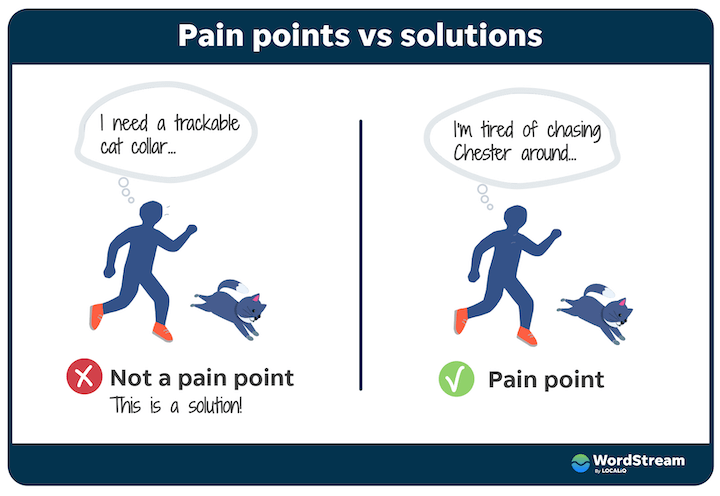
And remember: Your customer journey map isn’t meant to be all rainbows and unicorns. It’s okay if your pricing packages are hard to understand or if your waiting room is small. The point is to identify areas of improvement and/or communicate them to stakeholders so you can resolve them.
3. Desires
Your customers’ desires aren’t for a solution to each pain point. They are the reason, the greater benefit they attain as a result of solving the pain point. For example, the customer who is afraid to let their cat out isn’t directly desiring a trackable cat collar; but rather a solution because they have a desire to make their cat happy.
Desires may also refer to what the customer is looking for in the solutions to the pain points along their journey, such as to be able to chat with support online.
Back to our cat collar example, here are some desires:
- Awareness: A happy and safe cat.
- Consideration: A free trial or explainer video.
- Decision: Visual sizing chart.
- Service: Be able to use other apps concurrently.
- Retention: Car charging option.
4. Actions
Now, given the customer’s pain point and desire, what action are they going to take at that touchpoint? What action is the customer looking to complete at each stage in the journey? For this section, think about how hard or easy it is for them to do so. The goal, of course, is to reduce friction here as much as possible and make it easy to move on to the next action.
- Awareness: Read a blog post.
- Consideration: Compare product features.
- Decision: Make a purchase.
- Service: Track their cat and get the most out of their purchase.
- Retention: Upgrade the collar or app.
5. Expectations
Given the touchpoint and action they’re looking to take, what are your customers’ expectations here? This is different from their desires. The desire is what they want for themselves; the expectation is what they’re looking for out of their interaction with you. You can identify many expectations based on standard best practices and user experiences, but you’ll also want to look at your reviews, conduct surveys and ask questions.
- Awareness: A helpful blog post with additional resources, but not sales pitches.
- Consideration: Reasonable prices, a pricing chart with features.
- Decision: Ability to pay online with credit card.
- Service: Fast customer support.
- Retention: App updates and notifications.
Note: Not every unmet expectation leads to disappointment or a complaint, so make sure you ask the right questions to uncover these expectations as well—since meeting these will create a distinguished customer experience.
6. Emotions
These are not the emotions you want your customer to feel. It’s the emotions they actually feel at each stage, based on the pain point, touch point, and whether or not their expectations were met. Again, this is not meant to show perfectly happy customers at every stage. Customer journey mapping is about visualizing the journey so you can identify areas of improvement and harness what works.
If applicable, you may want to point out one positive and one negative emotion at each stage. For example:
- Awareness: Satisfied, even delighted with the fun and friendly tone of the blog posts and website.
- Consideration: Impressed with collar but doubtful about the app.
- Decision: Super-confident after talking to rep, but confused and concerned about choosing a size.
- Service: Grateful for the extensive knowledge base, but frustrated at not being able to chat with someone online.
- Retention:
7. Business goal/KPI
Now it’s time to identify what your business is trying to achieve at each stage in the buyer’s journey. This is sort of like the third (desires) and fourth (actions) steps, but for you. Ideally, you’ll be able to pinpoint specific, measurable goals for each stage. For example:
- Awareness: Create awareness; website sessions.
- Consideration: Increase traffic; pageviews, leads.
- Decision: Drive purchases; number of orders, average order value.
- Service: Improve reputation; customer reviews and referrals
- Retention: Reduce churn; customer lifetime value.
8. Teams involved
Last but not least, you’ll want to indicate who is involved at each stage of the journey. This will help your business to organize actionable steps for making the improvements identified in the exercise with clear owners. This, of course, will all depend on how your business is structured. For example:
- Awareness: Content and SEO teams
- Consideration: Product, sales, and acquisition teams
- Decision: Sales team
- Service: Sales and customer success teams
- Retention: Content and customer success teams
Free customer journey map templates
There are a number of ways to present the information, depending on your business model and who you’re presenting the information to.
1. WordStream’s free customer journey map template for Google sheets
One thing you’ll notice is that all of these templates look nice, but they all contain placeholder text. Sure, every business is unique, but we thought it’d be helpful to provide a template that’s more of a worksheet, and as you saw above, there’s also a tab with a populated example so you’re not starting from scratch.
Click here to get the free customer journey map template.
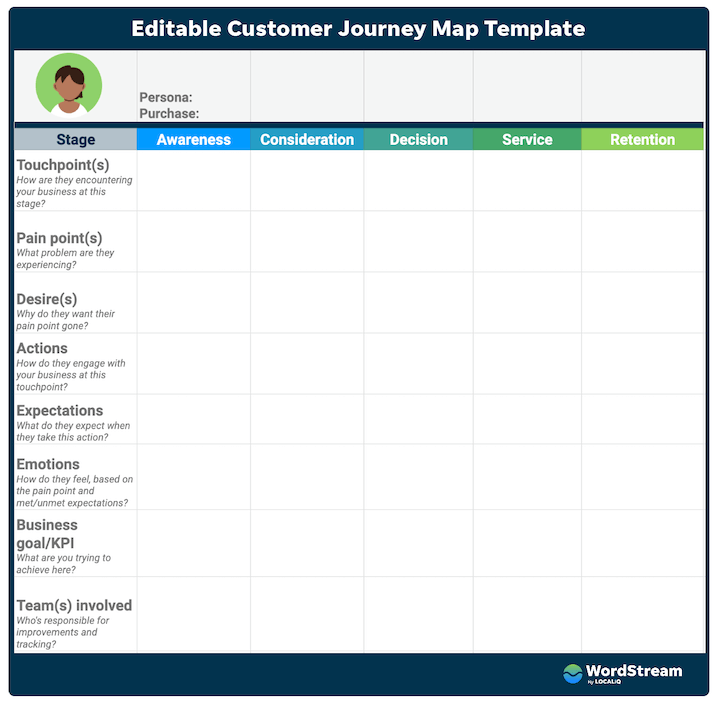
2. Slideegg’s customer journey map templates for Powerpoint
Slideegg offers tons of free customer journey map templates you can use for Powerpoint. Below is just one example, but there are additional formats including tables, steps, and infographics.
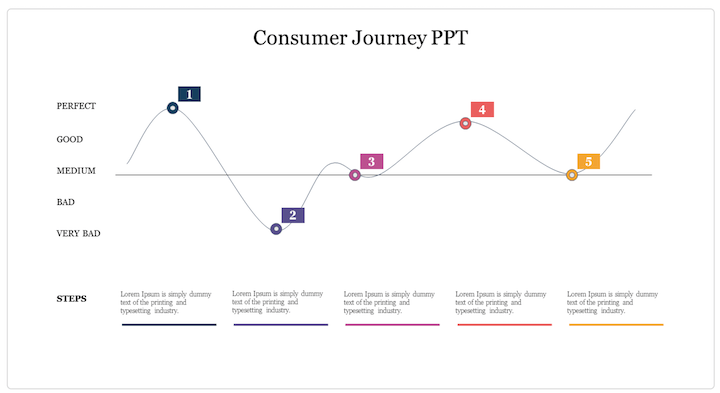
3. Youexec’s customer journey map slide deck template
Youexec.com provides a set of slides for customer journey mapping. You can pick one that works best for the information you’re capturing, or you might find that a combination of two or three slides together conveys everything.
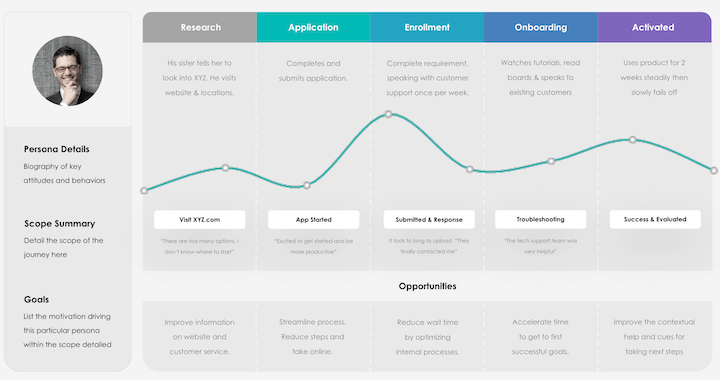
4. Slidego’s customer journey map template for Google slides
Slidego also provides a deck of beautiful customer journey mapping templates compatible with Google Slides. Like the collection above, you don’t have to use them all. In fact, don’t do that. Choose 1-3 that will clearly communicate the right information to whomever you’re presenting the map to.
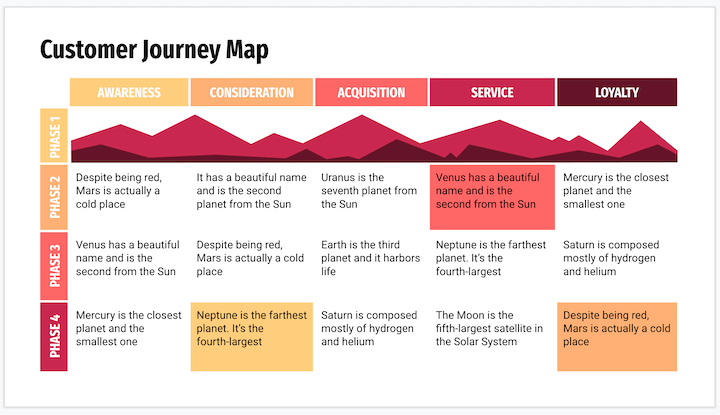
5. MightyBytes’ PDF customer journey map template
MightyBytes offers a super simple customer journey mapping template in PDF format. Best of all, it’s directly editable.

6. Visual Paradigm’s customer journey map template
Visual Paradigm offers dozens of free customer journey map templates. The only downside is that you have to create and customize them in the app. The app is free, but you’ll be limited in shareability and collaboration.
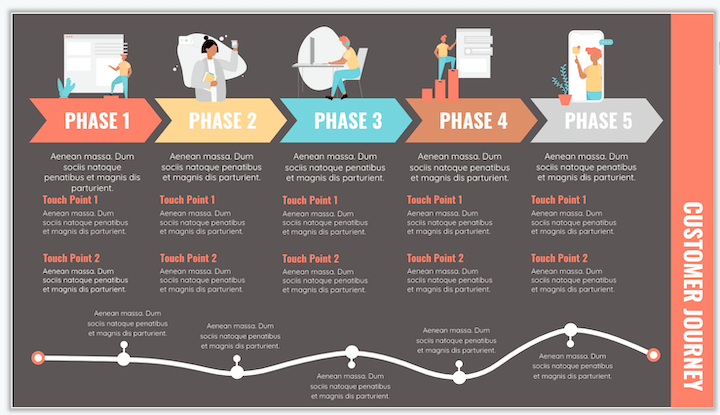
7. Miro
Similar to Visual Paradigm, our last template is brought to you by Miro another software tool. You’ll have to use the program to create the customer journey map, but it’s free to use.
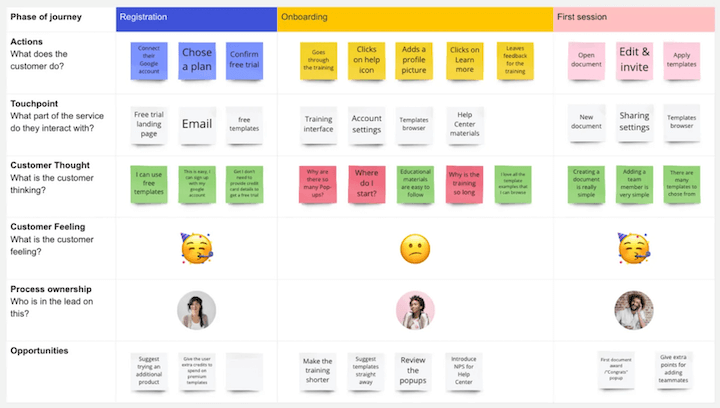
Get mapping
I know—creating a customer journey map feels like a journey in itself. It is, but it’s well worth the time and effort. Like I said, mapping out these micromoments and improving them will mean the difference between a good business and a great one.
Give it a try, and let us know how it goes!




